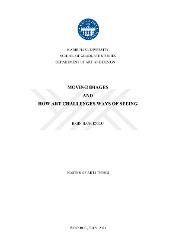| dc.contributor.advisor | Eviner, İnci | |
| dc.contributor.author | Hancioğlu, Ilgin | |
| dc.date.accessioned | 2023-10-17T20:46:24Z | |
| dc.date.available | 2023-10-17T20:46:24Z | |
| dc.date.issued | 2023 | |
| dc.identifier.uri | https://tez.yok.gov.tr/UlusalTezMerkezi/TezGoster?key=a0OMTmEd_3mfOBxT8SiBTDW7itbguGqo8I_uXx3Vf3iiMuBCRJObF-kQ0RP2ZghO | |
| dc.identifier.uri | https://hdl.handle.net/20.500.12469/4550 | |
| dc.description.abstract | Antik optik aparatlarından 21. yüzyılın sanal imgelerine kadar insanlar görmek, bakmak ve incelemek için aygıtları kullanagelmiştir. Bedenimiz ve dünyanın geri kalanı arasına konumlandırdığımız bu aletler mekanik olmaktan çok sosyal yapılardır. Bu aygıtlar kültürün hem bir ürünü hem de şekillendiricisidirler. Bir yandan yalın insan algısıyla tanık olunamayacak imgeleri görsel haznemize kazandırırken bir yandan da kendi görme biçimlerini nihai yöntem olarak sunarlar. Aynalar, lensler ve iğne deliği kameralar gibi yansıtma mekanizmaları anlık hareketli imgeler yaratabilir. Ne var ki üç boyutlu dünyayı iki boyuta soyutlarlar. Tek noktalı perspektif gerçekçi bir temsil biçimi olarak kabul görür, ama aslında katı ve insan-dışı bir görme biçimini standartlaştırır ve yaygınlaştırır. Kendinden önceki hiçbir tekniğin yapamadığı bir biçimde zamanın akışını donduran fotoğraf, yakaladığı bu anları insan gözünden kaçan gerçeklikler olarak sunar. Sabit imgelerin belirli bir hızda ardışıklığı ile oluşturulan hareketli imgeler ise kendi süreleri boyunca tek odak noktası olarak izleyicisini hareketsiz bırakır. Ekran, arkasındaki sanal bir derinliğe referans verirken hareketli imgelerin gerçek aygıtları gizlidir, yani izleyici aslında karşılaşmadığı mekanizmaların çıktılarını gözlemler. Yine de hareketli imgeler günümüzde o kadar yaygınlaşmıştır ki insan algısı yerine kameranın bakışı göz önüne alınarak düşünmek ve üretmek artık genel geçerdir. Bu çalışma, görme aygıtlarını sadece görsel kültürün teknik gelişmeleri olarak ele almak yerine bunları izleyenin bedeni ve bu bedenin tanzimindeki değişimler olarak inceler. Sanatı, bu yaygın yöntemlere itiraz eden bir yaklaşım olarak önerir. Sanatçıların, insan algısından kaçan bu aygıtları açığa çıkaran, ya da onlara karşı üreten eleştirel bakışı bize yeni görme biçimleri sunabilir ve dünyanın geri kalanını yeni bir bakışla keşfetmemiz için bize ilham verebilir. | en_US |
| dc.description.abstract | From ancient optical tools to virtual images of the 21st century, humans have used devices to see, look at, and observe. The tools of vision we place between our bodies and the rest of the world are social more than mechanical. These apparatuses are both the outcome and the agent of human culture. While devices introduce images impossible to witness through bare human perception into our visual knowledge, they also impose their ways of seeing as ultimate. The reflective mechanisms, like the mirror, the lens, and the pinhole camera, create instantaneous moving images. However, they also abstract the three-dimensional world into two. The single-point perspective is accepted as a realistic depiction style; however, it standardizes and establishes a rigid, non-humanistic way of seeing. While capturing the flow of time like never before, photography also presents these frozen instants as evidence that would otherwise elude the human vision. The moving image, that is, the illusion of movement of sequenced still frames at a certain pace, immobilizes its spectators for its duration as the sole focus of their attention. While the screen refers to a virtual depth, its apparatus is concealed, meaning, the viewer observes the outcome of a mechanism they do not encounter. However, it is so ubiquitous that it is common to think and create moving images for camera vision instead of human perception. This study inspects these seeing devices not just as technical developments of visual culture but as shifts of the spectator's body and its regulation. It proposes art as an exceptive approach against established methods. The critical approach of artists, by revealing the apparatuses that elude human vision or by working against it, can provide new ways of seeing and inspire us to explore the world with a new gaze. | en_US |
| dc.language.iso | eng | en_US |
| dc.publisher | Kadir Has Üniversitesi | en_US |
| dc.rights | info:eu-repo/semantics/openAccess | en_US |
| dc.subject | Felsefe | en_US |
| dc.subject | Philosophy ; Sahne ve Görüntü Sanatları | en_US |
| dc.title | Moving images and how art challenges ways of seeing | en_US |
| dc.title.alternative | Hareketli imgeler ve sanatın görme biçimlerini eleştirisi | en_US |
| dc.type | masterThesis | en_US |
| dc.identifier.startpage | 1 | en_US |
| dc.identifier.endpage | 93 | en_US |
| dc.department | Enstitüler, Lisansüstü Eğitim Enstitüsü, Sanat ve Tasarım Ana Sanat Dalı | en_US |
| dc.institutionauthor | Hancioğlu, Ilgin | |
| dc.relation.publicationcategory | Tez | en_US |
| dc.identifier.yoktezid | 818366 | en_US |
| dc.khas | 20231017-Tez | rn_US |
















